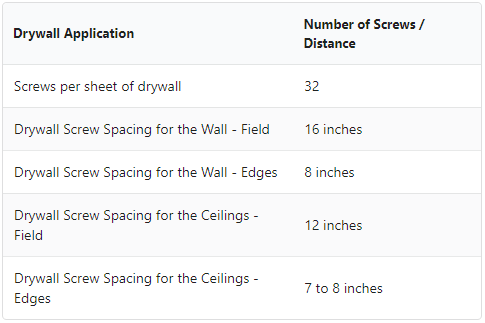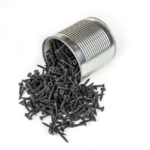Knowing how to install drywall, how many screws to use, and the spacing of the screw pattern into wall studs will help ensure a smooth and successful project.
Depending on local building codes, and the exact application, the screw pattern for drywall varies. Knowing the differences and what conditions require certain drywall screw patterns is important to get the job done right.
What is Drywall, and Why is it Popular?
A drywall sheet is a gypsum board installed on interior walls. It is also commonly referred to by other names in the industry, including sheetrock, wallboard, gypsum panel, buster board, and dry boards.
Drywall panels are made by pressing gypsum into a sheet and then covering two paper boards on each side to give a smooth finish. Gypsum plaster, foaming agents, glue, or other adhesives are added to hold the board together and provide strength and stability.
Drywall construction has been around since the early 20th century in the US to reduce the labor and material cost of plasterboard on wall studs. It has become the most common material used for interior wall construction thanks to its affordability, lightweight yet durable design, and ease of access and transport.
Drywall can be found in almost every type of modern-day structure. If you’re inside a building right now, it’s likely you are surrounded by drywall.
How Are Screws Used on a Sheet of Drywall?
The most common way to secure drywall sheets during construction is with specially designed drywall screws. Drywall screws make it easy to attach drywall to framing members.
There was a time when drywall was attached using drywall nails, but this has changed. Screws are much stronger and more efficient to install with a screw gun, but there are different requirements for screw spacing, depending on the application.
Compared to standard screws, drywall screws are made with deeper threads, holding tighter and offering more support and stability. With the correct screw, you can limit the dreaded screw pops.
The screws are steel and require a power screwgun to get them fully secured and in place. Considering the drywall sheets’ size and weight, especially when hung from ceilings, secure attachment and support are critical.
Drywall Screw Pattern Terms
Field – Any area of the sheet not at the drywall edge. The middle of the sheet.
Edge – The four sides or the perimeter of the drywall sheet. Keep drywall screws at least 1/2” to 3/8” from the edge of the sheet.

Types of Drywall Screws to Look Out For
There are several design options when selecting your drywall screws for a project. Each one can affect the drywall differently and impact how many screws you need and how they should be placed and secured to the drywall sheet.
The Phillips flathead, twelve-point, flathead slotted, flange head, and square-drive screws are the most widely used drywall screws. The most common lengths are S-type and W-type.
S-type screws are used primarily for drywall installations on metal studs. Their pointed end and shorter size make them easy to place and secure without excessive work to pierce through metal sheets.
Coarse thread, sharp point, bugle head drywall screws are typically used on wood studs.
W-type screws are the opposite and are much longer and thinner. The long narrow design with a fine thread helps hold the support material and secures the piece of drywall.
Drywall Screw Gauges Worth Remembering
The diameter of the screw is the gauge. The thicker the screw, the higher the gauge number. You should also consider the various gauges available, as they can impact your placement and spacing of drywall screws during a construction project.
Most drywall screws and fasteners have gauges of 6, 8, 10, 12, and 14. The most popular sizes are 6 and 8-gauge screws.
Remember, the larger the gauge, the bigger the hole it will make in the drywall due to the thicker the screw. Additionally, the larger the screw, the more it will weigh and the more it will impact spacing.
You may need more screws when using a size 6 compared to a 10, but if you are concerned about the weight, you might be better off using a size 6, so you aren’t adding much weight with the screws themselves.
Consider a variety of drywall anchors and check any building code regulations or municipality requirements to determine the size and type of screws you will need.
Overview of Drywall Screw Spacing and Common Sizes
Most of the time, drywall screws fasten full or partial drywall sheets to wood or metal surfaces. These drywall sheets are commonly available as 4-foot by 8-foot sheets for the average homeowner looking to do some DIY renovation.
Professional construction and renovation experts can use large sheets because they have multi-member teams and the equipment necessary to lift and hold larger sheets in place.
Both home improvement DIY projects and professional installations will use specific screws and anchoring patterns to ensure the drywall is safely and securely fastened into place.
Most drywall thickness is 1/2-inch or 5/8-inch. The odd 1/4-inch drywall is generally used for ceilings, curved or angled walls, irregular wall studs, and other applications where other sizes are too thick and heavy.
This is important to note because you will want screws that are long enough to penetrate the drywall and go deep enough into the supporting material to hold it securely in place.
Too shallow will not keep the drywall anchored, and too deep, and you are exerting more effort than needed to get each screw into place.
Determine How Many Drywall Screws Are Needed Per Sheet
Generally, you will want to use 32 drywall screws for every standard sheet of 4-foot by 8-foot drywall you are installing. Proper drywall screw spacing is critical to a successful installation.
You will need four screws on each of the 5 studs in the middle and six screws on each of the two long sides of the sheet.
It is important to note that building codes and regulations can vary, so this will be something to check to ensure local codes do not require more screws for this installation.
Also worth remembering is that hanging drywall on the ceiling will need additional screws to support all the weight safely.
You can also determine the number of necessary drywall screws by buying one screw per installed square foot of drywall. Calculating this for partial or larger sheets is easy. Divide the square footage of the wall by 32 to get the number of sheets you need.
Then, multiply by 32, which is the number of screws required per sheet. Remember, this is assuming you are using a 4’ x 8’ sheet of drywall.
Example: You have a bedroom with 320 square feet of wall space that needs drywall. Dividing 320 by 32 equals 10. You will need 10 sheets to cover the room with drywall.
Multiply 10 sheets by 32 to get 320, and you have the total minimum number of screws you will need to complete the project.
This is a handy formula to have on hand and in mind when doing any drywall installation project to ensure you have more than enough screws on hand.
How Far Apart Do Drywall Screws Need to Be?
Drywall screws should be placed approximately 16 inches on center in the “field.” The inner area of each sheet is referred to as the field and is the more stable area to secure drywall to studs.
Screws can be placed as close as 12 inches apart, but it is not very common to place them closer than that within the field area.
For horizontal placements on ceiling joists, many more screws will be necessary. There is far more stress on drywall with this sort of installation. Upside-down screws now carry the entire weight of the sheet.
This is where a 12-inch spacing is a regulation rather than an option in most cases.
Each edge of the drywall sheet must also be secured. As it’s the least durable and stable part of the sheet, more screws will be needed.
Industry professionals often use a 7 to 8-inch spacing for drywall screws when securing the edges of the sheets. This ensures they do not crack or buckle as they are installed.
Common Drywall Screw Spacing Questions
Can I Use Liquid Nails on Drywall?
Generally, if both are used to secure drywall, the screws can be placed at twice the distance recommended for screws only. However, it is not best for do-it-yourselfers, as the liquid nails and glue will bond firmly and cannot be adjusted.
If you make a mistake, you must tear down the drywall and complete the reinstallation.
Can I Put Too Many Drywall Screws Per Sheet of Drywall?
When installing sheets of drywall, it’s essential to use enough screws. If you use too few screws, the sheet can come loose or buckle and fall, creating a safety hazard.
If you use too many screws, you can add stress points or leave holes in the drywall, which will need to be fixed and covered.
How Long Should Drywall Screws Be?
For 5/8” thick drywall, use screws that are 1 5/8” in length. For 1/2” thick drywall, the most common length of drywall screws is 1 ¼ inch. For thicker drywall sheets, the recommended length is between 1 ⅝ and 2 inches.
You may have to adjust slightly based on what materials you are securing the drywall to, but these figures are a standard guideline for screw length preferences.



